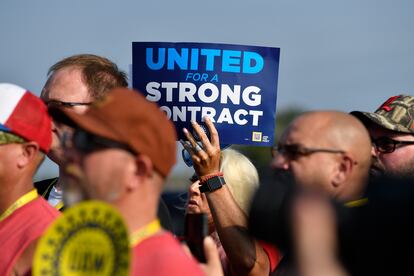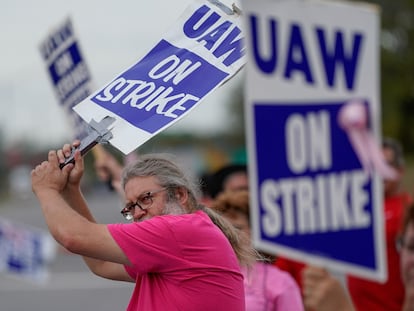Workers hit US auto giants with selective strike
The UAW union is behind walkouts at General Motors, Ford and Stellantis plants due to deadlock over a new collective bargaining agreement. It is the first time the union has acted against the Big Three simultaneously

About 13,000 U.S. auto workers stopped making vehicles and went on strike Friday after their leaders couldn’t bridge a giant gap between union demands in contract talks and what Detroit’s three automakers are willing to pay. Members of the United Auto Workers (UAW) union began picketing at a General Motors assembly plant in Wentzville, Missouri; a Ford factory in Wayne, Michigan, near Detroit; and a Stellantis Jeep plant in Toledo, Ohio.
It was the first time in the union’s 88-year history that it walked out on all three companies simultaneously as four-year contracts expired at 11:59 p.m. Thursday.
“For the first time in our history, we will strike all three of the Big Three at once,” said UAW president Shawn Fain in a video streamed on Facebook ahead of the walkouts. He described the moment as “historic” and explained the strategy of “standup” strikes at selected plants to try to hit the companies without wearing themselves out, or exhausting their resources with a general walkout.
“This strategy will keep the companies guessing. It will give our national negotiators maximum leverage and flexibility in bargaining, and if we need to go all out, we will,” said Fain in his brief speech.
The UAW represents about 146,000 employees across the three groups. It has a fund of $845 million with which to compensate striking employees who stop receiving their salaries. With all the employees on strike, that fund would barely last three months, since the union pays $500 a week to workers on strike, plus other costs.
The strikes will likely chart the future of the union and of America’s homegrown auto industry at a time when U.S. labor is flexing its might and the companies face a historic transition from building internal combustion automobiles to making electric vehicles.
The deadline for an agreement expired on Thursday at midnight. The union did not want an extension to the existing agreement, but a new one with significant salary increases that would compensate for the high inflation and the sacrifices made in times of financial difficulties.
the UAW targeted a handful of factories to prod company negotiators to raise their offers, which were far lower than union demands of 36% wage increases over four years. GM and Ford offered 20% and Stellantis, formerly Fiat Chrysler, offered 17.5%. In addition to general wage increases, the union is seeking restoration of cost-of-living pay raises, an end to varying tiers of wages for factory jobs, a 32-hour week with 40 hours of pay, the restoration of traditional defined-benefit pensions for new hires who now receive only 401(k)-style retirement plans, pension increases for retirees and other items.
Many say it’s time to get the concessions back because the companies are making huge profits and CEOs are raking in millions. “They could double our raises and not raise car prices and still make millions of dollars in profits,” Fain said. “We’re not the problem. Corporate greed is the problem.”
The strikes could weigh on the U.S. economy at a time when it is being hit by high interest rates and inflation. The walkout could even be a factor in next year’s presidential election by testing Joe Biden’s proud claim to be the most union-friendly president in American history.
“This is our generation’s defining moment,” said Fain in his address. “The money is there, the cause is righteous, the world is watching, and the UAW is ready to stand up. This is our defining moment.”
Sign up for our weekly newsletter to get more English-language news coverage from EL PAÍS USA Edition
Tu suscripción se está usando en otro dispositivo
¿Quieres añadir otro usuario a tu suscripción?
Si continúas leyendo en este dispositivo, no se podrá leer en el otro.
FlechaTu suscripción se está usando en otro dispositivo y solo puedes acceder a EL PAÍS desde un dispositivo a la vez.
Si quieres compartir tu cuenta, cambia tu suscripción a la modalidad Premium, así podrás añadir otro usuario. Cada uno accederá con su propia cuenta de email, lo que os permitirá personalizar vuestra experiencia en EL PAÍS.
¿Tienes una suscripción de empresa? Accede aquí para contratar más cuentas.
En el caso de no saber quién está usando tu cuenta, te recomendamos cambiar tu contraseña aquí.
Si decides continuar compartiendo tu cuenta, este mensaje se mostrará en tu dispositivo y en el de la otra persona que está usando tu cuenta de forma indefinida, afectando a tu experiencia de lectura. Puedes consultar aquí los términos y condiciones de la suscripción digital.
More information
Archived In
Últimas noticias
Reinhard Genzel, Nobel laureate in physics: ‘One-minute videos will never give you the truth’
Pinochet’s victims grapple with José Antonio Kast’s rise in Chile
How Japan is trying to avert ‘digital defeat’
The complicated life of Francesca Albanese: A rising figure in Italy but barred from every bank by Trump’s sanctions
Most viewed
- Pablo Escobar’s hippos: A serious environmental problem, 40 years on
- Why we lost the habit of sleeping in two segments and how that changed our sense of time
- Charles Dubouloz, mountaineering star, retires at 36 with a farewell tour inspired by Walter Bonatti
- Trump’s obsession with putting his name on everything is unprecedented in the United States
- The Florida Keys tourist paradise is besieged by immigration agents: ‘We’ve never seen anything like this’










































